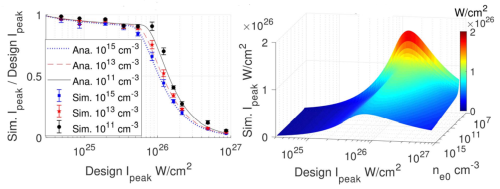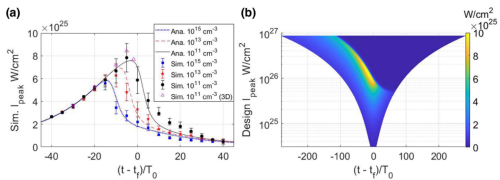What is the strongest laser one can build? This has been a central question since the invention of the laser. Recently, the research group from State Key Laboratory of High Field Laser Physics of Shanghai Institute of Optics and Fine Mechanics (SIOM), Chinese Academy of Sciences (CAS) have explored the upper limit of the laser intensity under non-ideal vacuum conditions based on simulations of the laser-plasma interaction in the quantum electrodynamics (QED) regime. The relevant results are published in Photonics Research on March 24, 2021.
In QED theory, the vacuum is not empty but full of quantum fluctuation of virtual particle pairs. For laser intensities approaching the Schwinger limit (~1029W/cm2), virtual electron-positron pairs can be turned into real lepton pairs, which consume the laser photon energies. This defines the upper limit of light intensity in a perfect vacuum.
In reality, it is unliked to have ideal vacuum conditions. In this case, the existence of residual electrons can seed QED processes like photon emission and electron-positron creation. These two processes can be cascaded to form QED plasma and deplete laser energy rapidly. Additionally, the leptons can be trapped in the laser field owing to the radiation reaction trapping effect, enhancing the process of depletion. Eventually, the laser intensity is limited at a much lower threshold due to.
The research group from SIOM developed a dynamical model to describe the evolution of the QED cascade in a non-ideal vacuum. This model perfectly pictured the evolution of gamma-photon emission and pair creation in 3D particle-in-cell (PIC) simulations. It is found that the laser peak intensity is suppressed starting from 1025W/cm2 and a clear upper threshold appears in the level when the residual electron density is higher than 109cm-3. Moreover, the attainable intensity as a function of vacuity is demonstrated according to the analytical model, which tallies well with PIC simulations. These results present a clarification for the achievable intensity at the current vacuity and offer a guideline for the construction of 100PW class laser facilities.
This work was supported by Strategic Priority Research Program of the Chinese Academy of Sciences and National Natural Science Foundation of China.

Fig. 1. The peak intensity from simulations as a function of design intensity and residual electron density. (Image by SIOM)

Fig. 2. The peak intensity evolution during intensity. (Image by SIOM)
Article Website:
https://doi.org/10.1364/PRJ.416555
Contact:
WU Xiufeng
General Administrative Office
Shanghai Institute of Optics and Fine Mechanics, CAS
Email: xfwu@siom.ac.cn
Web: http://english.siom.cas.cn/